Related Research Articles
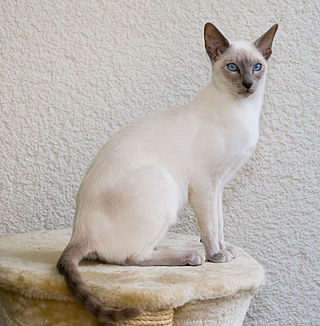
The Siamese cat is one of the first distinctly recognised breeds of Asian cat. Derived from the Wichianmat landrace, one of several varieties of cats native to Thailand, the original Siamese became one of the most popular breeds in Europe and North America in the 19th century. The carefully refined, more extreme-featured, modern-style Siamese is characterised by blue almond-shaped eyes; a triangular head shape; large ears; an elongated, slender, and muscular body; and various forms of point colouration. Other than colouration, the modern-style Siamese bears little resemblance to the original stock, and the more moderate, traditional, or "old-style" Siamese, with a much rounder head and body, has been re-established by multiple registries as the Thai cat.

The Sphynx cat also known as the Canadian Sphynx, is a breed of cat known for its lack of fur. Hairlessness in cats is a naturally occurring genetic mutation, and the Sphynx was developed through selective breeding of these animals, starting in the 1960s.

Mink are dark-colored, semiaquatic, carnivorous mammals of the genera Neogale and Mustela and part of the family Mustelidae, which also includes weasels, otters, and ferrets. There are two extant species referred to as "mink": the American mink and the European mink. The extinct sea mink was related to the American mink but was much larger.

Fur farming is the practice of breeding or raising certain types of animals for their fur.
ALC may refer to:
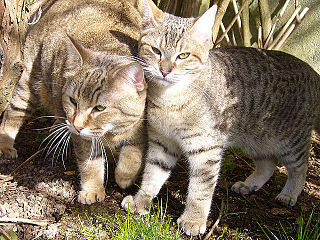
The Pixie-bob is a breed of domestic cat claimed to be the progeny of naturally occurring bobcat hybrids. However, DNA testing has failed to detect bobcat marker genes, and Pixie-bobs are considered wholly domestic for the purposes of ownership, cat fancy registration, and import and export. They were, however, selected and bred to look like American bobcats.

The champagne gene is a simple dominant allele responsible for a number of rare horse coat colors. The most distinctive traits of horses with the champagne gene are the hazel eyes and pinkish, freckled skin, which are bright blue and bright pink at birth, respectively. The coat color is also affected: any hairs that would have been red are gold, and any hairs that would have been black are chocolate brown. If a horse inherits the champagne gene from either or both parents, a coat that would otherwise be chestnut is instead gold champagne, with bay corresponding to amber champagne, seal brown to sable champagne, and black to classic champagne. A horse must have at least one champagne parent to inherit the champagne gene, for which there is now a DNA test.

The American mink is a semiaquatic species of mustelid native to North America, though human introduction has expanded its range to many parts of Europe, Asia, and South America. Because of range expansion, the American mink is classed as a least-concern species by the IUCN. The American mink was formerly thought to be the only extant member of the genus Neovison following the extinction of the sea mink (N. macrodon), but recent studies, followed by taxonomic authorities, have reclassified it and the sea mink within the genus Neogale, which also contains a few New World weasel species. The American mink is a carnivore that feeds on rodents, fish, crustaceans, frogs, and birds. In its introduced range in Europe it has been classified as an invasive species linked to declines in European mink, Pyrenean desman, and water vole populations. It is the animal most frequently farmed for its fur, exceeding the silver fox, sable, marten, and skunk in economic importance.
Glma may refer to:
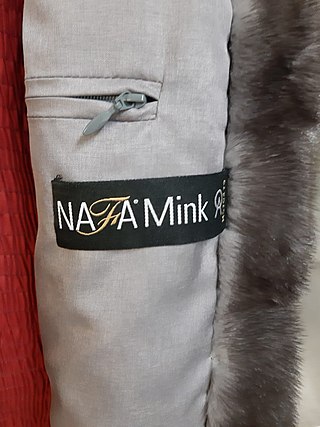
North American Fur Auctions is a Canadian company that auctions on consignment fur pelts harvested in Canada and the United States. Its services are used by both large fur farms and small-time trappers. Its auctions are held three to four times a year in Toronto. It is the largest fur auction house in North America, and the second largest in the world.
Heineken N.V. is a Dutch brewer which owns a worldwide portfolio of over 170 beer brands, mainly pale lager, though some other beer styles are produced. The two largest brands are Heineken and Tecate; though the portfolio includes Amstel, Fosters, Sagres, Cruzcampo, Skopsko, Affligem, Żywiec, Starobrno, Zagorka, Zlatý Bažant, Laško and Birra Moretti.

The science of cockatiel colour genetics deals with the heredity of colour variation in the feathers of cockatiels, Nymphicus hollandicus. Colour mutations are a natural but very rare phenomenon that occur in either captivity or the wild. About fifteen primary colour mutations have been established in the species which enable the production of many different combinations. Note that this article is heavily based on the captive or companion cockatiel rather than the wild cockatiel species.
The Fur Institute of Canada (FIC) works to promote the fur trade and to advocate for the fur industry. The organization, has more than 100 members from industry and trade, government, Aboriginal groups and the scientific community.
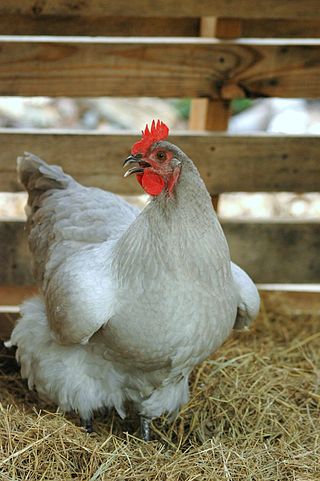
Lavender or self-blue refers to a plumage color pattern in the chicken characterized by a uniform, pale bluish grey color across all feathers. The distinctive color is caused by the action of an autosomal recessive gene, commonly designated as "lav", which reduces the expression of eumelanin and phaeomelanin so that black areas of the plumage appear pale grey instead, and red areas appear a pale buff.
Colours of the Syrian hamster can be described in three ways: as "self", "agouti" or "combinations". Self colours are a consistent coat colour with the same colour topcoat and undercoat. Agouti hamsters have a ticked coat, where each individual fur is banded in different colours. Agouti hamsters also have "agouti markings" which consist of dark cheek markings, a dark marking on the head, and a light underbelly. Combinations are produced when two self or agouti colours are present.
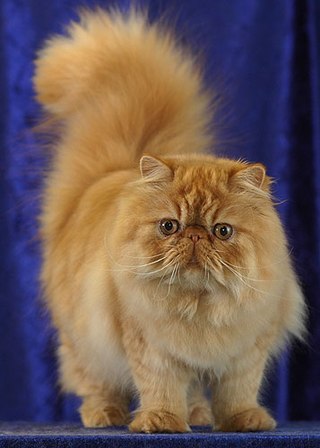
The Persian cat, also known as the Persian Longhair, is a long-haired breed of cat characterised by a round face and short muzzle. The first documented ancestors of Persian cats might have been imported into Italy from Khorasan as early as around 1620, however, this has not been proven. Instead, there is stronger evidence for a longhaired cat breed being exported from Afghanistan and Iran from the 19th century onwards. Widely recognised by the North-West European cat fancy since the 19th century, and after World War II by breeders from North America, Australia and New Zealand. Some cat fancier organisations' breed standards subsume the Himalayan and Exotic Shorthair as variants of this breed, while others generally treat them as separate breeds.
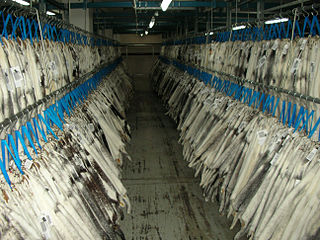
The mink industry in Denmark produced 40 percent of the world's pelts. Denmark used to be the largest producer of mink skins in the world. Ranked third in Denmark's agricultural export items of animal origin, fur and mink skins have a yearly export value of about €500 million. Kopenhagen Fur, located in Copenhagen, is the world's largest fur auction house; annually, it sells approximately 14 million Danish mink skins produced by 2,000 Danish fur farmers, and 7 million mink skins produced in other countries. Mink produced in Denmark was considered to be the finest in the world and is ranked by grade, with the best being Saga Royal, followed by Saga, Quality 1, and Quality 2.

Cluster 5 is a designation used by the Danish Statens Serum Institut for a virus variant described by the institute in autumn 2020, in connection with investigations of SARS-CoV-2 infection among mink and humans in the north of Jutland, Denmark.
Anna Maximilian Potok was a Polish-born fur designer and, with her brother, Maximilian Apfelbaum co-founder of the New York furriers Maximilian.
References
- ↑ Richard M. Shackelford, "Domestic Production of Mink and Foxes", Proceedings of the Twenty-Ninth annual National Breeders' Roundtable, 1980. full text Archived 2007-09-27 at the Wayback Machine
- ↑ "Midwest Fur Producers Ass'n v. Mutation Mink B. Ass'n, 127 F. Supp. 217 (W.D. Wis. 1955)".
- ↑ "NAFA Acquires Blackglama Label - NAFA". www.nafa.ca. Archived from the original on 2018-06-29.
- ↑ "Cascadia Capital Advises American Legend Cooperative in its Acquisition by North American Fur Auctions", April 19, 2018
- ↑ "American Legend Cooperative Membership". Archived from the original on 2007-10-22. Retrieved 2009-01-01.
- ↑ North American Fur Industry Communications group (NAFIC).